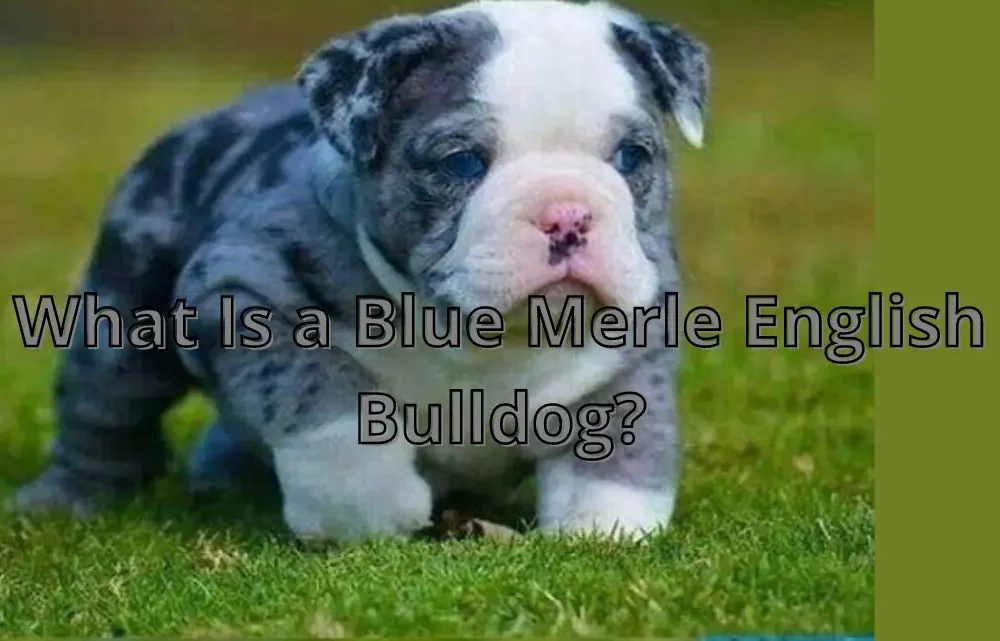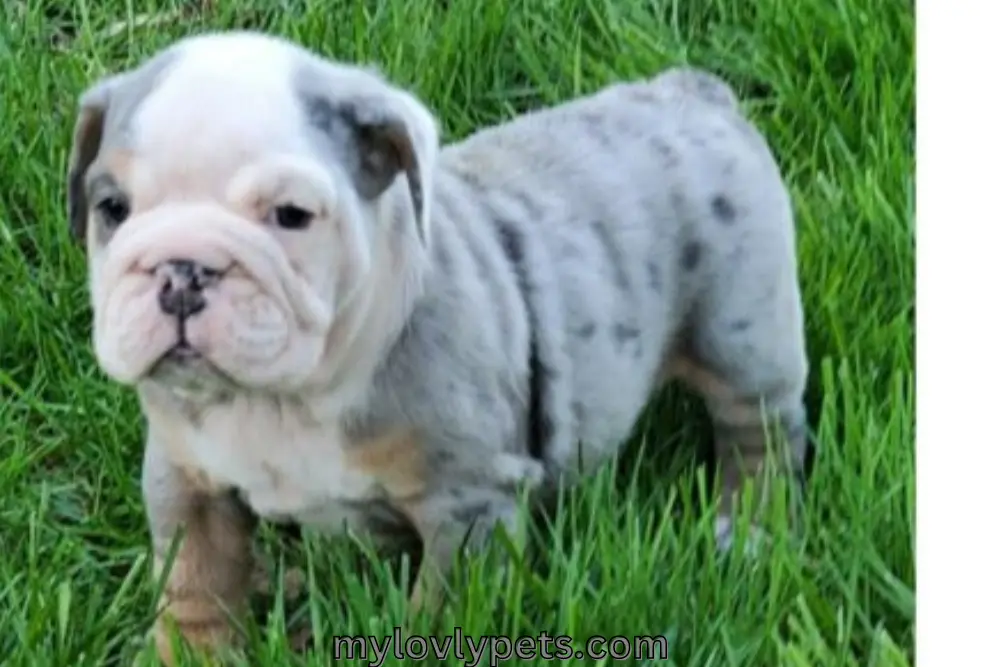
Blue Merle English Bulldog: A Comprehensive Overview
Breeding dogs has long been a hobby for dog enthusiasts looking to create a specific type of dog through a combination of breeds. The combination’s primary motivation was to reduce health problems and enhance the dog’s overall quality of life.
Nonetheless, there are examples of breeding processes that occurred only for aesthetic reasons, such as a change in coat color. Among the numerous possible color combinations for a Merle English Bulldog’s coat are blue, lilac, tri, and black. They have gorgeous coats, and their blue eyes stand out. Because of their attractiveness, it is not surprising that Blue Merle English Bulldog have gained so much popularity.
The emergence of the blue merle coat color has caused a recent surge in the popularity of dogs. If you want to know what is a blue merle English bulldog? and have any queries about Merle English Bulldogs, they should all be answered in this article.
What Is A Blue Merle English Bulldog?
New dog breeds are a source of great joy in the canine community. The distinction is striking, regardless of whether it involves merely a shift in hue or a more fundamental alteration of form.
The blue merle English bulldog is one of the many new dog breeds that stands out for its distinctive coat color.
A Blue Merle English Bulldog is a black dog whose coat has been lightened by the merle gene. The black color has faded in several places to a bluish-grey hue. The coat of some Blue Merle English Bulldogs is gray-blue, mainly with a few black patches. The merle gene gives this breed its distinctive pattern of coloring.
The blue merle English bulldog is a relatively new addition to the canine community. Merle English Bulldogs have a striking appearance, but potential owners should be informed that they often result from improper breeding procedures and may have visual and auditory abnormalities.
This does not mean that all Merle English Bulldogs have been the product of poor breeding or that they will necessarily experience any health problems, but rather that the risk is more significant than a typical English Bulldog.
Characteristics of Blue Merle English Bulldogs
Blue Merle English Bulldogs are unique dogs with striking coat patterns. They have a marbled or mottled coat with patches of different shades, making them visually captivating. These medium-sized dogs typically weigh 40 to 60 pounds and stand 16 to 20 inches tall. They have distinct facial features, like a broad muzzle and round, wide-set eyes.
In terms of personality, Blue Merle Bulldogs are friendly, affectionate, and great for families. They are known for their loyalty and patience, especially with children. These dogs are generally well-behaved and can be trained with positive reinforcement.
What is Blue Merle English Bulldog Health Issues
As mentioned earlier in this article, merle English bulldogs have a significantly higher chance of inheriting a range of conformation defects and genetic flaws alongside their merle coloration, which is the basis of the main objections made against the color’s presence within the breed at all.
The English bulldog breed (regardless of the color of its dogs) is strongly associated with risk factors for a wide range of hereditary health conditions. It ranges from BOAS or brachycephalic obstructive airway syndrome to skin and coat allergies, patellar luxation, eye problems, heart defects, and many others.
Additionally, English bulldog puppies usually have to be delivered by cesarean section due to the relative size of the pups’ heads compared to the dam’s pelvis. Some English bulldogs also require assistance with mating due to the narrowness of the dog’s hips.
When it comes to merle English bulldogs, many health issues pertain specifically to dogs of the breed that are merle colored and which can be inherited alongside the genes that cause the distinctive merle coat color to be present in the first place.
The merle color in English bulldogs is associated with a heightened risk of hereditary deafness that may affect either both ears or just one, which can be either partial or complete. Additionally, English bulldogs with merle coloration may also suffer from blindness or poor eyesight and may have abnormally formed or improperly developed eyes.
Neither deafness nor vision problems automatically occur in all merle English bulldogs. Still, they do manifest in a significant enough number of merle dogs to be considered to pose a threat to the quality of life of affected dogs and the health of the breed as a whole.
Merle coloration can also cause a lack of pigmentation across certain areas of the skin. It may also lead to an increased risk of the dog developing skin cancer or hypersensitivity to light.
Does AKC Recognize Blue Merle English Bulldogs?

Registering your dog with the American Kennel Club (AKC) is impossible because the merle pattern needs to be recognized in the English Bulldog breed standard. You can’t enter them in shows or competitions, either.
One major factor is that merle is not a genetically determined coat color for the breed. Moreover, the potential health issues for dogs with this gene have been the center of the debate.
The United Kennel Club (UKC), another US kennel organization, only registers piebald English Bulldogs with symmetrical solid-color patches. Dogs with Merle coats do not meet this standard because the patches need to be uniformly distributed.
Blue Merle Olde English Bulldog
The United Kennel Club (UKC) officially recognized the Olde English Bulldogge as a breed of dog in January 2014. The United Kennel Club classifies the breed as a guard dog.
The Olde English Bulldogge is a powerful and agile dog with the build of a medium-sized dog. They look to be proportional and well-balanced, with no breathing problems in either extreme heat or cold. Severe wrinkling, and a distinct lack of pigmentation around the lips, nose, and eyes, are both major flaws.
Although they are susceptible to the same diseases as any other breed of dog, the Olde English Bulldogge may be in better health than many contemporary bulldog breeds. The breed’s supporters argue that their dogs are immune to the diseases that affect purebred Bulldogs.
What’s a Blue Tri Merle English Bulldog?
There is no difference between a Blue Merle English Bulldog and a Blue Tri Merle English Bulldog. Their coat features a striking mottled pattern of blue, grey, white, and brown. Usually, most of their hair is grey and blue, with smaller white and tan patches all over it. Blue Tri Merle English Bulldogs can have either brown or blue eyes, and their noses are either black or grey with pink patches.
English Bulldog Blue Merle Adoption Consideration
There are a number of things to think about if you’re looking into adopting a Blue Merle English Bulldog. Despite their eye-catching coat pattern, these dogs have special requirements and health risks.
First, keep in mind that there is some debate about whether or not to breed Blue Merle Bulldogs due to the risk of causing health issues including deafness and eye defects. Some major kennel groups don’t acknowledge the breed because of these issues. Be sure you adopt from a trustworthy organization and check into the required documentation.
Care for a Blue Merle Bulldog is unique. Their unique coat may require frequent brushing. Their exercise requirements are low to moderate, but you should take care against overheating in hot weather. Health complications include brachycephalic airway syndrome and skin disorders that need close observation.
Full Grown Blue Merle English Bulldog
A fully grown blue merle English Bulldog will be around the same size and weight as a standard English Bulldog. They are classified as a medium-sized breed.
On average, they are 14 to 15 inches tall. As adults, males weigh about 50 pounds and females about 40 pounds. A merle English Bulldog reaches its adult height around the first birthday. However, they might continue to put on adult weight and develop a full chest until they are two years old.
Due to the breed’s propensity for weight gain, it’s essential to start feeding your puppy a healthy diet from an early age.
How to Care for Blue Merle English Bulldogs
As this breed is prone to skin diseases and dental issues, they require more attention than others. You have to do daily oral checks. Indicators of dental decay or bad breath may indicate issues with gums or teeth. It’s also important to keep their skin folds, which are prone to infection, clean and dry.
Look at the creases on their necks, faces, and at the base of their tails. If you notice any dirt or dust, you can wipe it away with some damp cotton wool. It’s also important to clean their tail, especially if it’s screwed. Skin issues can be avoided by keeping their folds dry and clean.
Blue Merle English Bulldog Puppy Feeding
Merle, Blue English Bulldogs are distinguished by their short, sleek, and straight coat. You simply need to brush their fur once a week. Feathering and curling aren’t an issue. A regular dog brush will work fine for grooming their coat.
Changing the Blue Merle English Bulldog puppy’s food brand should be done gradually, and the pup should be fed at regular intervals. They should also be fed a well-balanced diet and evaluated based on the first five ingredients on the product label.
You need to see a vet if your pet starts having skin issues, vomiting, or other symptoms of food intolerance. Keep an eye on their size and BMI for a general indication of their health. A dog with a regular weight has a tucked abdomen, whereas an overweight dog does not. When a dog is underweight, his ribs become plainly visible and can be felt through the skin.
Blue Merle English Bulldog Price
Bulldogs are an expensive breed of dog, whether merle or not. Blue Merle English bulldogs price start at $9,500!
Their price is based on many things, but the most important is how famous bulldog puppies are on the market. Also, breeding is a complicated, time-consuming, and complex process.
The low-profit margins on these puppies have caused a lot of stress for dog breeders. Some could even experience a financial loss!
Depending on their coat color, merle puppies can range from several hundred to over a thousand dollars. Some tri-merle dogs cost even less than regular-colored dogs because they pose high health risks.
French and English merle bulldogs are hard to market due to health concerns. Merle English bulldogs start at $9,500! A French bulldog in blue merle can run you between $6,000 and $8,000. They are the most exotic of house pets. Blue merle bullies are extremely rare, and their high price reflects their rarity.


